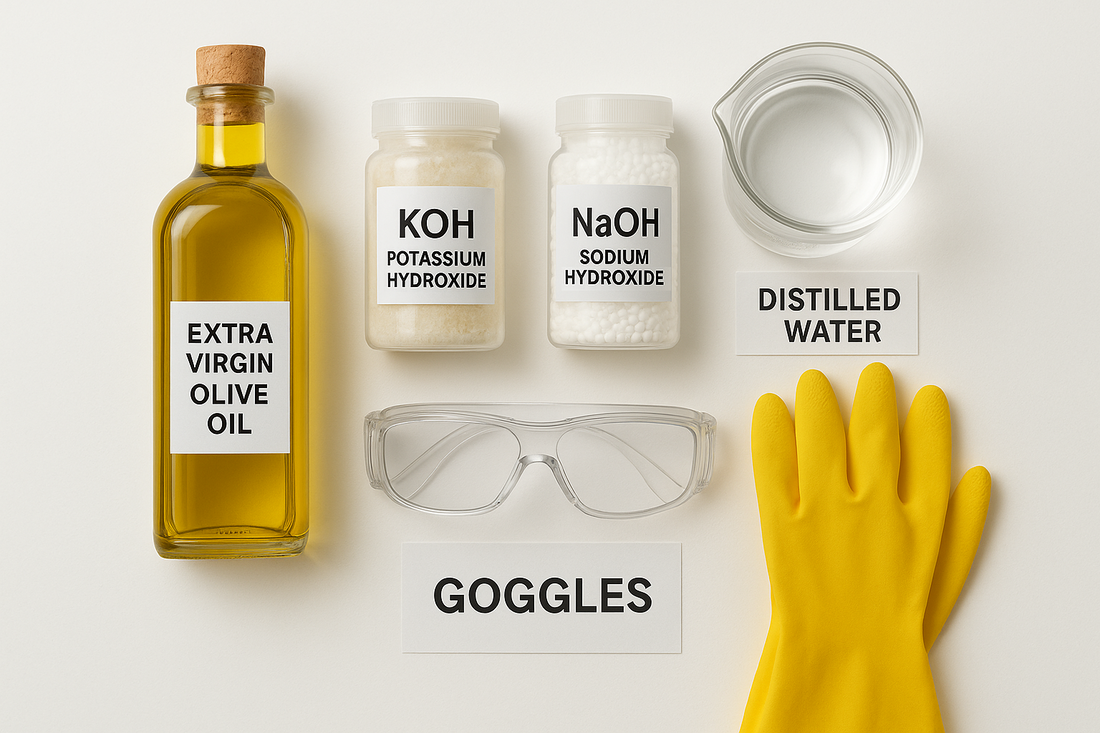
The Tale of Two Castile Soaps: Making Liquid Soap From Scratch vs. Melting a Bar
Liquid Castile soap is a popular, versatile cleaner praised for its simplicity and natural ingredients. But how exactly do you get from solid fats and lye to a pourable, translucent liquid soap? Our sources discuss a couple of different approaches, highlighting key differences in ingredients and process. Let's explore the journey of making liquid Castile soap.
Understanding the Basics: Lye is Key
Regardless of the method, soapmaking always involves a chemical reaction called saponification, which occurs when fats or oils react with an alkali, also known as lye [1-3]. The type of lye used is the fundamental difference between solid bar soap and true liquid soap [4]. Sodium hydroxide (NaOH), often called caustic soda, is used to make hard bar soaps [3-5]. Potassium hydroxide (KOH), or caustic potash, is used to make soft or liquid soaps [3-6].
Safety First! It's crucial to handle lye with extreme caution in a well-ventilated area, wearing safety gloves and goggles, as it is highly corrosive [7-10]. Never add water to lye; always add lye carefully to the water to avoid splattering or erupting [7, 10].
Method 1: Making True Liquid Castile Soap From Scratch (Hot Process)
Making liquid soap from scratch, while potentially taking a little more time and effort than cold process bar soap, can be well worth it, especially compared to the price of store-bought options [4, 11, 12]. This method results in a "true" liquid soap [13].
1. Ingredients
The core ingredients for a pure liquid Castile soap are olive oil, potassium hydroxide (KOH), water, and glycerin [6]. Pure olive oil is traditionally the only oil used in true Castile soap, originating in Spain [14]. Using pure olive oil results in a gentle soap, great for body cleansing [15, 16]. While some might broaden the definition to include other vegetable oils like coconut oil, adding different oils will change the soap's properties and require recalculating the lye amount using a saponification chart or calculator [6, 14, 17].
2. The Process
To make a clear liquid soap, a hot-process method is typically used, which involves cooking the soap [11, 18]. A slow cooker is the easiest way to do this [11, 19].
- Olive oil is placed in the slow cooker [19, 20].
- In a separate container, the KOH is carefully added to the water and glycerin mixture in a well-ventilated area [8, 20] (remember your safety gear!).
- The lye solution is slowly added to the olive oil and stirred [20, 21].
- An immersion blender is used to blend the mixture until it thickens to a pudding-like consistency [20, 21] (this stage is often called 'trace').
- The soap paste is then covered and cooked in the slow cooker for 3-4 hours, stirring every half hour [18, 21, 22]. This cooking completes the saponification process immediately [11, 18].

3. Checking for Doneness
How do you know when your soap paste is finished cooking? Perform a clarity test: dissolve a small amount (about a teaspoon) of the soap paste in about half a cup of hot distilled water. If the water turns clear (or mostly clear), the paste is done [18, 22]. If it remains cloudy or milky, cooking needs to continue for another half hour before re-checking [22, 23].
Using distilled water for this test and the final dilution is important for clarity, as minerals in tap water can cause cloudiness [21, 23, 24].
4. Dilution
Once the soap paste is ready, it needs to be diluted with water to become the liquid soap you can use [23]. This typically involves adding hot distilled water to the paste.
You can break up the paste and add the hot water, letting it dissolve over several hours or overnight, or by warming the water and paste [24, 25]. Some makers leave the mixture on a 'keep warm' setting in the slow cooker to speed things up [25], while others let it liquefy at room temperature over a longer period (a day or two) [25]. Stir occasionally to help it along.
Again, using distilled water for dilution helps ensure clearness and minimizes potential microbial contamination introduced by tap water [24].
5. Customization
Want to add fragrance? Essential oils or skin-safe fragrance oils can be added after the soap paste is diluted and has cooled slightly [26, 27]. This is different from cold process bar soapmaking, where fragrances are often added at trace [26].
6. Preservatives
The need for a preservative in homemade diluted liquid soap is a topic of discussion [27-30]. While the high pH of soap is naturally antimicrobial to some extent [27], the high water content in diluted liquid soap can potentially allow for microbial growth over time, especially compared to a solid bar [29]. Some commercial liquid Castile soaps often contain preservatives [28]. Research preservatives suitable for high-pH aqueous products if you choose to use one.
Method 2: Melting Down Bar Soap (Diluting a Bar)
You might wonder: can't I just melt down a bar of Castile soap to make liquid soap? While you can dissolve grated bar soap in water [13, 31], this approach generally doesn't produce the same result as true liquid soap made with potassium hydroxide.
- Simply diluting bar soap in water typically results in a "gloopy mess" rather than a true, transparent liquid soap [13].
- The texture and appearance are different from a true liquid soap [13].
- Diluted bar soap may also lack the same cleaning power as a bar soap or a true liquid soap [13].
This difference is primarily because bar soap is formulated with NaOH to be solid [4, 5]. Simply adding water doesn't change the fundamental nature of the soap molecules in the same way that using KOH from the start does [3-5].
In Conclusion
While melting down a bar of soap might seem like a shortcut, making liquid Castile soap from scratch using potassium hydroxide (KOH) via the hot process method is the way to achieve a true liquid product [4, 11, 13, 16, 32]. This method gives you control over ingredients and results in a soap with the desired clear, fluid texture and effective cleaning properties.
Though it requires careful handling of lye and specific tools like a slow cooker and immersion blender [20, 33], many soapmakers find creating their own authentic liquid Castile soap from scratch to be a rewarding process [4, 11].

References
- Ariza, T. (2019, January 26). Easy, Beginner DIY Liquid Castile Soap Recipe. Oh, The Things We'll Make! (Note: Updated date June 4, 2021 is also present, but the original publication or primary listed date is often used unless it's a significant revision).
- Helbig, K. (2014, December 16). Homemade soap, the traditional Castile way. Koren Helbig.
- Stocker, S. (2025, March 10). How to Make Liquid Castile Soap. wikiHow. (Note: Susan Stocker is listed as a co-author, and the article is marked as "Approved" and co-authored by 20 individuals).
- Clara. (2018, September 2). Lye Calculation Using a Saponification Chart – Tutorial. Auntie Clara's Blog.
- Handcrafted Soap and Cosmetic Guild. (n.d.). Lye Safety. (Note: The original publication date of Winter 2005-2006 is mentioned, but a specific current date is not provided in the excerpt for this online resource).
- [No Author]. (n.d.). Making True Liquid Castile Soap. (Note: This appears to be the blog post generated previously, and no author or publication date is listed in the excerpt provided).
- Aaron, A. (2016, December 18). Olive Oil in Soap Making – Properties + Recipes. [Lovin Soap Studio?]. (Note: Amanda Aaron is listed as the author, and the site name appears to be Lovin Soap Studio based on the footer, but this isn't explicitly stated as the source name in the excerpt title).
- Alum, B. N. (2024). Saponification Process and Soap Chemistry. INOSR Applied Sciences, 12(2), 51-56. https://doi.org/10.59298/INOSRAS/2024/12.2.515600
- [No Author]. (2022, January 31). Soap Much Misinformation: Twelve Common Soap Making Myths Explained. [The Ultimate Guide to Soap?]. (Note: "ultimatehpsoap" is mentioned, and "The Ultimate Guide to Soap" is in the footer, suggesting the site name, but no specific author name is listed in the excerpt).
- Classic Bells Ltd. (n.d.). Soapy Stuff: Preservative in liquid soap. Classic Bells. (Note: Copyright dates 2002-2025 are listed, but a specific publication or last updated date for the article is not present).
